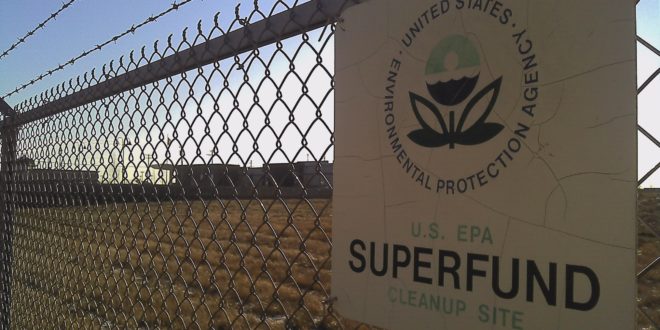Podcast: Play in new window | Download (Duration: 8:22 — 5.5MB)
The town of Spencer resisted being named a Superfund site by the EPA.
According to EPA documents obtained by WFHB, Spencer officials pushed back on the EPA’s designation, due to fears that being named a Superfund site would negatively affect property values.
The town’s aquifer was named a Superfund site by the EPA last month. Superfund sites are eligible for federal funding to clean up environmental contamination. In the case of Spencer, the Indiana Department of Environmental Management and the EPA found unsafe levels of the dry-cleaning chemical tetrachloroethene, or PCE. The chemical, which can be carcinogenic, leaked into the town’s municipal well field, which provides water to nearly 10,000 residents.
John Reeves is an environmental officer with the Owen County Health Department. According to both the EPA document and Reeves, officials have yet to pinpoint the source of the contamination. Reeves also said that the information regarding the town’s contaminated water been publicly available for quite some time. According to him, the water contamination hasn’t been a major public issue up until last month.
The town’s main concern with listing Spencer as a Superfund site is a fear of adverse economic impacts. According to the EPA documents, the town was concerned that the designation could needlessly alarm citizens and “Damage business reputations, affect property values, and require us to incur unnecessary costs.”
The EPA argued that there are benefits to listing the town. Those benefits include the potential for a federally financed clean-up and reduced human exposure to highly dangerous, and in this case carcinogenic, chemicals and contaminants.
According to the EPA documents, Spencer town officials also said there was no reason to list the town as a Superfund site because the drinking water quality was within acceptable parameters. They stated that because the groundwater was being treated for contamination before being served as drinking water, the town’s water met federal safe drinking water standards.
According to the EPA, that doesn’t matter. The quality of the final drinking water doesn’t make a difference in the naming of a Superfund site, as the decision is made based on the quality of the water in the aquifer.
The town pointed out that the information the EPA and IDEM were using was outdated, and that agencies did not take into account for a new well that the city had put in in an area outside the contaminated zone. So the EPA and IDEM took the new well into account in updated analyses. The town still qualified for the national Superfund registry by a wide margin.
Indiana University’s School of Public and Environmental Affairs Associate Professor Dr. Diane Henshel, an expert in the field of environmental pollutants, said adding new wells and treating drinking water are temporary solutions.
Echoing Henshel’s sentiments, IDEM commissioner Bruno Pigott, with support from governor Eric Holcomb, wrote in support of naming the town as a Superfund site. Pigott and Holcomb stated the move is necessary to assure a long-term response plan and allow for proper investigation into the extent of the contamination.
Adding Spencer to the EPA’s Superfund list does not mean it will warrant immediate remedial action. According to the EPA, the move is simply a decision to inform the public of potential environmental dangers. It won’t be until federal officials examine the site in the coming months that a decision on treatment, and environmental cleanup, is made.
The Town of Spencer and BBP Water Utility say they’re occasionally blending water from the uncontaminated municipal well with the other contaminated wells, on an as-needed basis.
According to Henshel, the effects of consuming contaminated water and living near an untreated superfund site may take years to manifest. She said that the chemical effecting Spencer’s water supply, PCE, is small and water soluble. It is heavy enough to sink to the lowest level of the groundwater, however, and it’s water solubility means it can move in unexpected ways and permeate from the Spencer well supply into nearby bodies of water and soil.
It’s not unusual for towns and cities to push back against EPA aid. It often takes some towns years to to finally agree to be added to the EPA’s registry. That’s precious clean-up time that’s lost, all while entire communities are exposed to contamination, according to Henshel.
The Indiana Department of Environmental Management declined multiple requests for comment on this story.
Below is a link to the complete EPA document, which details many of the complaints Spencer had and the specific findings of the federal agency and IDEM.
 WFHB Bloomington Community Radio
WFHB Bloomington Community Radio


